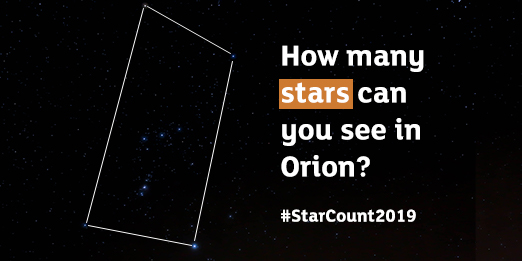Count the stars and help to save them
February 8, 2019
Written by Emma Marrington, Senior Rural Policy Campaigner at Campaign to Protect Rural England. Image above © Matthew Savage.
When was the last time you experienced a truly dark, star-filled night sky, even in the countryside? Or saw the beauty of the Milky Way clearly? It’s part of our national heritage but I suspect that there are many children nowadays who are so used to living under the constant glow of light pollution that they too would be astounded by a truly dark night sky.
Dark skies filled with stars are one of the most magical sights our countryside has to offer, but light pollution often ruins our experience of it and blurs the distinction between town and countryside. CPRE’s Night Blight maps showed that just 22% of England is untouched by light pollution – but what’s really astounding is that more than 90% of the South Downs National Park, the most populous of all England’s parks, is considered dark. This means it has minimal light pollution – and is why it was awarded international Dark Sky Reserve status. It shows that the presence of towns and villages doesn’t mean we should give up on seeing a glorious night sky – and you can help find out how we’re all doing.
CPRE, with support from the British Astronomical Association, is running a Star Count throughout February and we’re inviting people to be ‘citizen scientists’ and take part in a cosmic census that will help map light pollution – and our truly dark skies – across the country.
Stargazers are being asked to count the number of stars they can see within the constellation of Orion, which is only visible in the winter months. The Star Count will take place from Saturday 2 February – Saturday 23 February. It coincides with the South Downs National Park’s own Dark Skies Festival, which starts on 15 February – we’d love people to count the stars in Orion and tell us how many they’ve seen!
How to take part in Star Count 2019
Between Saturday 2 and Saturday 23 February 2019:
Try to do your count on a night when the sky is clear, with no haze or clouds, then wait until after 7pm so the sky is really dark.
- Looking south into the night sky, find the Orion constellation, with its four corners and ‘three-star belt’. Take a few moments to let your eyes adjust, then simply count the number of stars you can see within the rectangle made by the four corner stars. You should not count the corners, but you can count the three stars in the middle – the belt.

- Count and make a note of the number of stars seen with the naked eye (not with telescopes or binoculars) and then simply complete the online survey form: www.cpre.org.uk/starcount
- Share your experiences with others on social media using #starcount2019 @CPRE @BritAstro
- Check back to see the national results and see how your area compares to the rest of the country!
As for me, I’m looking forward to heading to the South Downs to take part in the Dark Skies Festival, and will wrap up warm in the hope of clear starry skies!
